A HISTORY OF THE LIVER, SPLEEN, AND GALLBLADDER
![]() "Now, why is the stomach surrounded by the liver? Is it in order
that the liver may warm it and it may in turn warm the food? This is indeed
the very reason why it is closely clasped by the lobes of the liver, as
if by fingers." -- Galen, ca. 200 A.D.
"Now, why is the stomach surrounded by the liver? Is it in order
that the liver may warm it and it may in turn warm the food? This is indeed
the very reason why it is closely clasped by the lobes of the liver, as
if by fingers." -- Galen, ca. 200 A.D.
Medical practitioners in antiquity identified the liver as one of the three principal organs of the body, along with the heart and the brain. They differed quite dramatically, however, on the relative importance of each. It was the Roman anatomist Galen who made the liver the principal organ of the human body, arguing that it emerged first of all the organs in the formation of a fetus. "The liver is the source of the veins and the principal instrument of sanguification," he observed in On the Usefulness of the Parts of the Body. For Galen, it was the liver rather than the heart where blood was most actively formed; it was a warm, moist organ. If all veins exchanged fluids through the liver, connecting only tenuously to the heart in order to provide a tiny amount of blood to mix with spirit in the arteries, then the liver was the center of the circulation of material substances in the body.
Galen identified the gall bladder and
spleen as the two crucial subsidiary organs of the liver. All three organs
worked together to produce and store three of the four humors of the body:
blood (liver), yellow bile (gall 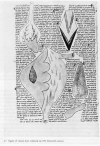 bladder)
and black bile (spleen). In essence, three-quarters of the substances
which established the balance of a healthy body could be found in this
region. Both the gall bladder and spleen prevented the blood formed in the
liver from being contaminated by denser and more toxic fluids. Galen
observed that the "spleen serves to purify the liver" and that the
"passages from the gall bladder have evidently been formed for
separating the bile." Puzzling over the location of the spleen, Galen
hypothesized that the large size of the stomach and the necessary proximity of
the bladder to the liver "to receive the thin, yellow residue" had led
to its unusual distance from the liver since, logically, nature "would have greatly preferred to place the spleen,
which attracts the thick, muddy residue right below the port where the atrabilious
residue, borne down by its own weight, would automatically sink into it."
The medieval illustration to the left suggests the way in which anatomical
illustrations helped to depict the fit of different organs to each other.
Can you see Galen's ideas in the drawing?
bladder)
and black bile (spleen). In essence, three-quarters of the substances
which established the balance of a healthy body could be found in this
region. Both the gall bladder and spleen prevented the blood formed in the
liver from being contaminated by denser and more toxic fluids. Galen
observed that the "spleen serves to purify the liver" and that the
"passages from the gall bladder have evidently been formed for
separating the bile." Puzzling over the location of the spleen, Galen
hypothesized that the large size of the stomach and the necessary proximity of
the bladder to the liver "to receive the thin, yellow residue" had led
to its unusual distance from the liver since, logically, nature "would have greatly preferred to place the spleen,
which attracts the thick, muddy residue right below the port where the atrabilious
residue, borne down by its own weight, would automatically sink into it."
The medieval illustration to the left suggests the way in which anatomical
illustrations helped to depict the fit of different organs to each other.
Can you see Galen's ideas in the drawing?
In the Middle Ages, the strength of the Galenic model of the body is amply apparent in descriptions of all three organs. Calling the liver "the seat of the nutritive or vegetative faculties," the Islamic medical philosopher Avicenna observed, "Physicians regard the liver as the seat of manufacture of the dense part of the humors." He further specified the liver's uniquely heavy and moist condition as a function of the fact that the organ itself was nothing more than a dense concentration of blood rather than being made of actual tissue. He also noted that the primary function of uroscopy -- reading urine -- was to understand the health of the liver. Thus by the early eleventh century, medical practitioners had consolidated their views of the importance of the liver into an elaborate regime of diagnosis and therapy.
Despite these strong statements about
the centrality of the liver, Avicenna indicated his sympathies to the Greek
philosopher Aristotle's view of the body when he observed: "All agree that the brain and the
liver each receive their power
of life, natural heat, and breath from the heart, and that each of them
is also the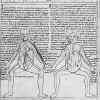 starting-point of another faculty which it sends out to the
other agents." The fundamentally different accounts of the body
offered by Galen and Aristotle proved to be an endless source of confusion for
their medieval and Renaissance readers. Other nagging questions remained
in regards to what exactly the liver generated of the humors. In the late
twelfth century, for example, Master Nicolaus expressed his uncertainty on this
question when he wrote: "Some say that the blood alone is generated, in form as well as
substance, in the liver, the other humours are generated there in substance
but in other places as to form." Yet he was nonetheless quite sure of
its overall purpose, as "the spiritual instrument
of the second digestion." Look at the late medieval physiology to the
right. How have the illustrators dealt with these problems?
starting-point of another faculty which it sends out to the
other agents." The fundamentally different accounts of the body
offered by Galen and Aristotle proved to be an endless source of confusion for
their medieval and Renaissance readers. Other nagging questions remained
in regards to what exactly the liver generated of the humors. In the late
twelfth century, for example, Master Nicolaus expressed his uncertainty on this
question when he wrote: "Some say that the blood alone is generated, in form as well as
substance, in the liver, the other humours are generated there in substance
but in other places as to form." Yet he was nonetheless quite sure of
its overall purpose, as "the spiritual instrument
of the second digestion." Look at the late medieval physiology to the
right. How have the illustrators dealt with these problems?
Yet another problem regarded the number
of lobes of the liver. Generally ancient and medieval anatomi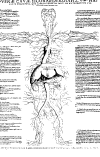 sts
sts 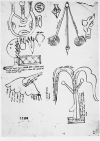 found
five (the number in a dog). Renaissance anatomists were less sure about
this number because increased dissection of human cadavers had suggested
alternatives. "It has five lobes, sometimes
four and three, sometimes two," wrote Jacopo Berengario da Carpi at the end
of the fifteenth century. A few decades later, anatomists were even more
skeptical of the five-lobed human liver. It is very rarely divided into five lobes; more frequently
into four most frequently into three," wrote Andres de Laguna in 1535.
The number that we count today -- two -- seems to have been quite difficult for
them to see. Look at the medieval image of the liver to your
left. Then look at a Renaissance image of the liver to your
right. What differences do you observe?
found
five (the number in a dog). Renaissance anatomists were less sure about
this number because increased dissection of human cadavers had suggested
alternatives. "It has five lobes, sometimes
four and three, sometimes two," wrote Jacopo Berengario da Carpi at the end
of the fifteenth century. A few decades later, anatomists were even more
skeptical of the five-lobed human liver. It is very rarely divided into five lobes; more frequently
into four most frequently into three," wrote Andres de Laguna in 1535.
The number that we count today -- two -- seems to have been quite difficult for
them to see. Look at the medieval image of the liver to your
left. Then look at a Renaissance image of the liver to your
right. What differences do you observe?
While the liver may have been the most importance organ to observe and describe in this sector of the body, the gall bladder and spleen also provided interesting material to contemplate. Humoral theory suggested that each had a profound effect on the emotions. The gall bladder regulated the emotions by being a repository for gall. "Its substance is slender," wrote Berengario, "because it does not digest anything and hard so that it may resist the sharpness of the gall." Attached to both the heart and the brain, it was a truly sensitive organ that could affect other parts of the body. Similarly, the spleen, repository of the most noxious substance of the body -- black bile -- prevented the onset of melancholia by containing the bodily fluid that producted this mental state. "Similarly [according to] other physicians the spleen [is] the receptacle of melancholy as the gall bladder of gall; wherefore the spleen causes one to laugh," wrote William Harvey in his Lectures on the Whole of Anatomy (1653). The ability to laugh was a sign that the spleen was working well.
Despite any lack of knowledge of the lymphatic system, which was not identified until the middle of the seventeenth century, Renaissance physicians nonetheless understood that the spleen played an important role in fighting off disease. "It helps the entire body by purging the bloody mass from the feces ... and suffers all manner of illnesses," wrote Berengario. In this instance, a humoral account of the body did anticipate what further anatomical investigation would reveal.
Renaissance accounts of all three organs are filled
with tiny inconsistencies that reflect the growing amount of information that
came as the result of repeated dissections. While
some physicians continued to follo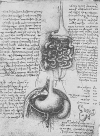 w the teachings of the ancients, others began to
privilege evidence obtained directly from the human
body in their practice of medicine. Harvey still spoke of the liver as a
"noble organ" in 1653 and the spleen as an "ignoble
organ." But he also went to great pains to offer a physical
description of each organ. He described the gall bladder as "a very long pear compressed from base
into neck" and the spleen as "like the tongue of an ox [or] the
sole of the foot; slightly bowed out on the left side, a little
concave on the inner side, toward the stomach. It has an uneven surface
and is a little rough with some tubercles." Even as many aspects of
physiology remained uncertain, the anatomy became more precise. Leonardo's
depiction of the liver, for instance, is a good example of the changes that
observation gradually made in accounts of the body, as well as the difficulties
of overcoming what one already knew to describe what there was to see.
w the teachings of the ancients, others began to
privilege evidence obtained directly from the human
body in their practice of medicine. Harvey still spoke of the liver as a
"noble organ" in 1653 and the spleen as an "ignoble
organ." But he also went to great pains to offer a physical
description of each organ. He described the gall bladder as "a very long pear compressed from base
into neck" and the spleen as "like the tongue of an ox [or] the
sole of the foot; slightly bowed out on the left side, a little
concave on the inner side, toward the stomach. It has an uneven surface
and is a little rough with some tubercles." Even as many aspects of
physiology remained uncertain, the anatomy became more precise. Leonardo's
depiction of the liver, for instance, is a good example of the changes that
observation gradually made in accounts of the body, as well as the difficulties
of overcoming what one already knew to describe what there was to see.
Between the 1640s and 1660s, increased numbers of animal vivisections allowed anatomists to look more closely at the relationship between the liver and the newly discovered lymphatic system. Their research suggested that the all-important chyle, which Galen had describing as being converted into blood after it flowed in the liver, took a different pathway through the body. Johannes van Horn wrote in 1652: "I categorically deny that even one lactic vessel goes to the liver." The great Danish anatomist and discoverer of the lymphatic system, Thomas Bartholin, was initially more tentative. That same year he wrote, "I do not have the courage to doubt the liver which has so long been considered essential." Yet in his Lymphatic Vessels (1653), he confidently reversed this view, declaring the end of the liver's role as "ruler of the abdomen" and the death of the "sanguine empire." Bartholin ultimately decided that the role of the liver was to form bile rather than blood. In 1654, the English physician Thomas Glisson was the first scholar to publish a book devoted exclusively to the Anatomy of the Liver. He continued to wonder about the connections between the liver and the glands.
QUESTIONS: WHY WAS THE LIVER SUCH AN IMPORTANT ORGAN? WHY DID PHYSICIANS OFFER SO MANY DIFFERENT DESCRIPTIONS OF THESE THREE ORGANS, BUT ESPECIALLY THE LIVER?
Return to History of the Body Home Page